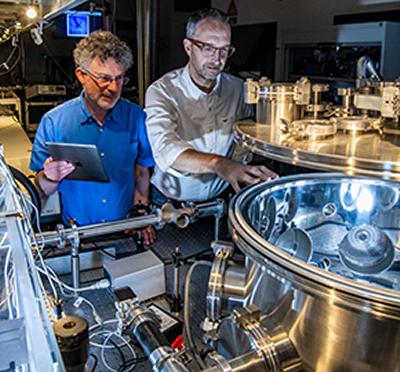Developing lensless imaging at the nanoscale

Interdisciplinary researchers from Chemistry, together with colleagues at the Zepler Institute for Photonics and Nanoelectronics, are planning collaboration with a leading UK institution – The Rosalind Franklin Institute – to develop imaging that can look at biological systems at a much higher resolution and definition.
Professor Jeremy Frey, from Chemistry, and Dr Bill Brocklesby, from the Zepler Institute, are among the first researchers in the world to demonstrate lensless imaging on real biological samples using extreme ultraviolet light, which gives much higher resolution than conventional optical microscopy.
The research is one of a number of interdisciplinary University of Southampton life science projects working closely with The Rosalind Franklin Institute, which aims to transform life science through interdisciplinary research and technology development. The Rosalind Franklin Institute supports the development of technologies allowing the biological world to be viewed in new ways, from single molecules to entire systems, accelerating drug design and development, and advancing our understanding of human health and disease.
Through the University’s Institute for Life Sciences (IfLS), Southampton is one of 10 universities at the core of The Rosalind Franklin Institute, working with industrial and academic partners to foster interdisciplinary research, at scale, with impact.
The partnership is recognition of Southampton’s renown both nationally and internationally for the strength and breadth of its interdisciplinary life sciences research.
Jeremy and Bill are leading research to develop an innovative microscope where measurements can be taken from samples without having to modify the sample beforehand.
Jeremy said: “Usually metal coatings or fluorescent dyes need to be added to samples before the images are taken, but this research is developing a coherent light source that is opening up a whole new way of looking at the sub-cellular structure, revealing information that hasn’t been seen at this level before.
“By taking this novel technology to The Rosalind Franklin Institute, we will have access to complementary large equipment enabling us to improve the resolution of our lensless imaging method to the nanoscale.”
Bill added: “We are hoping that the images we can now produce of nanoscale biological structures can make a case for investment in the next generation of these tools. We will be creating a pathway that could make this imaging equipment more compact allowing it to be rolled out for use more generally in biology.”
Southampton’s research in this field will contribute to the theme of correlative imaging which is a focus of development at The Rosalind Franklin Institute.
IfLS Director Professor Peter JS Smith, said: “At Southampton, we are capable of contributing to a number of the core themes of the Rosalind Franklin Institute, particularly through our research in disruptive advances in imaging technologies from the large scale down to the atomic scale. By feeding into projects at The Rosalind Franklin Institute, we will be at the forefront of cutting-edge technology development that will help drive our own research forward.”